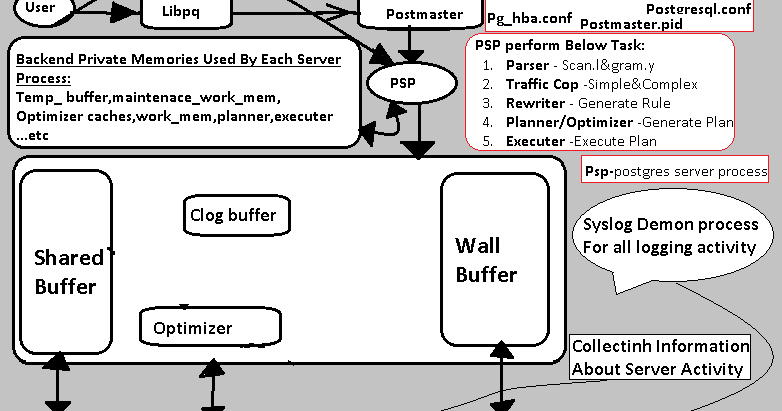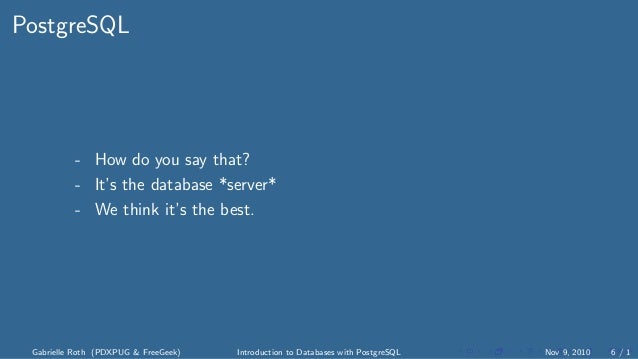

- Postgresql tutorial how to#
- Postgresql tutorial driver#
- Postgresql tutorial password#
- Postgresql tutorial windows#
PostgreSQL was developed for UNIX-like platforms, however, it was designed to be portable.
Postgresql tutorial how to#
Postgresql tutorial driver#
In the PostgreSQL Unicode ODBC Driver (psqlODBC) Setup dialog box, click Save to close the dialog box.

If the connection failed, use the information in the message to resolve any issues.Ĭlick OK to close the Connection Test box. The Connection Test box opens containing a message describing whether the connection was successful. In the PostgreSQL Unicode ODBC Driver (psqlODBC) Setup dialog box, click Test to test the connection. The Advanced Options ( driverName) 2/2 dialog box closes. The Advanced Options ( driverName) 2/2 dialog box opens. (Optional) Micro Focus recommends that you select the Use Declare/Fetch check box, to reduce memory use.The Advanced Options ( driverName) 1/2 dialog box opens.
Postgresql tutorial password#
The password for the user account that connects to the database server. The port to use to communicate with the database server. For instructions, refer to the PostgreSQL documentation. To enable SSL mode, you must also configure the database server to support SSL.

Whether to use SSL to connect to the database server. The user name to connect to the database server with.Īn optional description for the data source. The IP address or hostname of the server that the database server is installed on. The name of the database that you created in Step 2. Media Server uses this string to connect to the database server. The PostgreSQL Unicode ODBC Driver (psqlODBC) Setup dialog box opens.Ĭomplete the data source information fields: Data Source Select the PostgreSQL Unicode driver from the list and click Finish. The Create New Data Source dialog box opens. The ODBC Data Source Administrator dialog box opens.
Postgresql tutorial windows#
In the Windows Control Panel, click System and Security. Is the user name that Media Server will connect as. Is the name of the database that you created. GRANT USAGE ON ALL SEQUENCES IN SCHEMA public TO userName GRANT EXECUTE ON ALL FUNCTIONS IN SCHEMA public TO userName GRANT SELECT, INSERT, UPDATE, DELETE ON ALL TABLES IN SCHEMA public TO userName If security is not a consideration you could grant all privileges, but the required privileges are: Databaseįor example: GRANT TEMP ON DATABASE databaseName TO userName Grant privileges to the user that Media Server will connect as.

The psql command-line tool does not recognize backslashes in file paths. Replace backslashes in the file path with forward slashes. Run the script using the command: \i 'path/postgres.sql' Micro Focus recommends running the following command to ensure that the script stops running if it encounters an error: \set ON_ERROR_STOP on The schema is inserted inside the public schema. This script sets up the database schema that Media Server requires. Run the postgres.sql script provided in the Media Server installation directory. Database nameĪny that is compatible with the encoding.įor example: CREATE DATABASE myDatabase WITH ENCODING 'UTF8' LC_COLLATE='English_United Kingdom' LC_CTYPE='English_United Kingdom' Ĭonnect to the new database using the command: \c databaseName Run a CREATE DATABASE command to create a new database. In the Windows Command Prompt, run the command: psql -U userName If the directory path is not added to the PATH variable, you must specify the psql.exe file path in the Command Prompt to start psql. This step enables you to use the command psql to start the PostgreSQL command-line tool (psql) from the Windows Command Prompt.


 0 kommentar(er)
0 kommentar(er)
